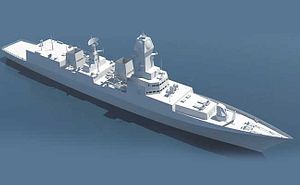The Indian Navy will launch its second Project 15B Visakhapatnam-class guided missile destroyer, christened Mormugao, at the Mazagaon Dock Limited (MDL) shipyard in Mumbai on September 17 ahead of schedule, according to local media reports. During the launch the warship will be floated on water for the first time. The ceremony will be attended by the Chief of the Naval Staff, Admiral Sunil Lanba.
As I reported previously (See: “China Beware: Here Comes India’s Most Powerful Destroyer”), the lead ship of the Visakhapatnam-class, Visakhapatnam, was launched in April 2015 and is expected to be commissioned in July 2018. The Mormugao is set to enter service with the Indian Navy in 2019. Two more vessels of the class are planned.
The warships of the Visakhapatnam-class are based on the older Project 15A Kolkata-class destroyers design, three of which will join the Indian Navy by the end of 2016. The Kolkata-class destroyer INS Kolkata was commissioned in August 2014, with the other two remaining warships of the class to be commissioned by the end of the year.
The Visakhapatnam-class is the most advanced destroyer class ever to be built in India, according to Indian defense officials. Displacing 7,300 tons, the stealth guided missile destroyer has a crew of 50 officers and 250 sailors. It is powered by four Ukrainian gas turbine engines, and capable of reaching a maximum speed of about 30 knots. The ship’s operational range is around 4,000 nautical miles.
Around 65 percent of components of the Vishakhapatnam-class are domestically designed and produced, including 11 of its weapon and associated sensor systems, according to Indian naval officials. The multirole warship features a host of new weapon systems, as I noted elsewhere:
The principal armament of the Visakhapatnam-class will be eight BrahMos supersonic cruise missiles, which boast an operating range of 290 km and were co-developed by India’s Defense Research and Development Organization (DRDO) and the Russian defense industry.
The BrahMos is capable of traveling at speeds of up to Mach 3.0, making it one of the world’s fastest cruise missiles, and operates on a so-called fire and forget principle. Furthermore, I explained:
In addition, the ships will be equipped with the Barak-8/NG — an Indo-Israeli surface-to-air missile (SAM) — jointly developed by Rafael-IAI and the DRDO. The weapon was successfully tested in Israel in November 2014. The Visakhapatnam can carry up to 32 of these medium-long range air defense missiles.
Furthermore, the ship boasts a license-built 76 mm Oto Melara Super Rapid Gun, four fully-automated Russian AK-630 close-in weapon systems (likely fitted on the vessel’s bow), and a yet-to-be-selected 127 mm gun (however, local media sources claim that the ship will just be armed with a 127 mm main gun instead of a 76 mm Super Rapid Gun Mount).
The Multi-Function Surveillance Threat Alert Radar (MF-STAR) is the Israeli equivalent to the U.S. Navy’s Aegis Combat System and allegedly on par with the Chinese “Aegis” system installed on the Type 052D Multirole Destroyer.
For antisubmarine warfare, the new stealth guided-missile destroyer features twin-tube launchers and RBU-6000 Smerch-2 rocket launchers. It can also carry two multiple-role helicopters (e.g., Sea King or HAL Dhruv helicopters).
The total cost of the program is estimated at around $4.9 billion.

































